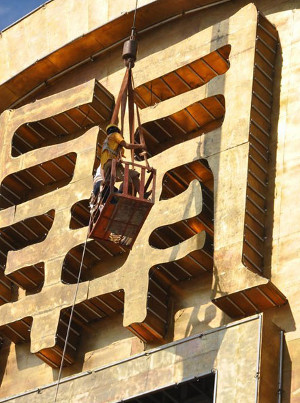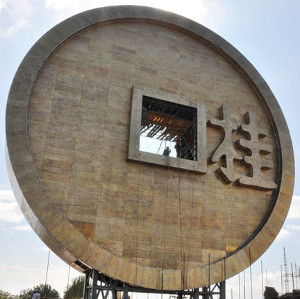In the year 621 AD, Emperor Gaozu of the newly established Tang Dynasty introduced a new coin with the inscription kai yuan tong bao (開元通寶) which set a standard that lasted for some 1200 years.
Although the last kai yuan tong bao coin was cast many centuries ago, a new kai yuan tong bao coin recently appeared in Guiyang Prefecture (桂阳县) which is part of the city of Chenzhou (郴州) located in China’s southern province of Hunan (湖南).
The ancient coin measured about 24 mm in diameter. The new “coin” is actually a sculpture and is considerably larger with a diameter of 24 meters (78.7 feet).
This is the largest copper coin sculpture in the world according to Chinese news reports published August 30, 2013.

World’s largest copper coin sculpture at the Baoshan National Mining Park in Guiyang.
At the left is the image of the new copper sculpture of a kai yuan tong bao coin being put on display at the Baoshan National Mining Park (宝山国家矿山工园).
The Baoshan National Mining Park is a theme park commemorating the long history of mining in the area which dates back to the Han Dynasty (206 BC – 220 AD).
The new coin sculpture will be open to the public beginning in the middle of September.
The coin sculpture has an internal steel structure with copper sheets on the exterior. It has a thickness of 3.8 meters (12.5 feet).

A construction worker is dwarfed by the huge Chinese characters on the coin sculpture.
This image gives a better indication of the large scale of the sculpture.
Workers are dwarfed by the huge size of the Chinese characters forming the coin’s inscription.
The calligraphy on the original coins was done by Ouyang Xun (欧阳询) who was one of the most famous calligraphers of the time.
The style is a unique combination of “seal” (zhuan 篆), “official” (li 隶) and “regular” (kai 楷) scripts evoking a solemn and dignified appearance which had a profound impact on the calligraphy used on the generations of cash coins that followed.
The coins cast during the earlier years of the Tang Dynasty had no Chinese characters on the reverse side although some did exhibit “moons” (月) and “stars” (星).
This changed, however, during the reign (840-846) of Emperor Wu Zong who was devotee of Daoism. During his “Huichang” (会昌 841-846) era, he ordered the confiscation of copper statues, bells, gongs, etc. from Buddhist temples and used the copper to cast kai yuan tong bao coins.
These “Huichang” period coins are distinguished from the earlier ones by having a Chinese character on the reverse side indicating where the coin was minted.
There were a total of 22 mints operating at the time.
One of the 22 mints was in Guiyang near where the coin sculpture is located.
Coins cast at the Guiyang mint had the Chinese character gui (桂) on the reverse side.

The Chinese character “gui” represents the coin mint in Guiyang during the Tang Dynasty.
As can be seen in the image at the left, the reverse side of the coin sculpture also has the Chinese character gui (桂).
Emperor Wu Zong reigned for only 6 years.
The “huichang” era kai yuan tong bao coins did not begin to be produced at the Guiyang mint until the 5th year (845) of this reign period. Coins with the “gui” (桂) mint mark were only cast for a little more than one year.
The news reports state that because not many of these coins were cast, they are now fairly difficult for coin collectors to obtain.
As already mentioned, this sculpture of a copper coin is believed to be the largest in the world. The Guiyang Tourism Department has arranged for representatives from Guinness World Records to visit the site this month to verify the fact.
(A video of this large coin sculpture may be seen here.)